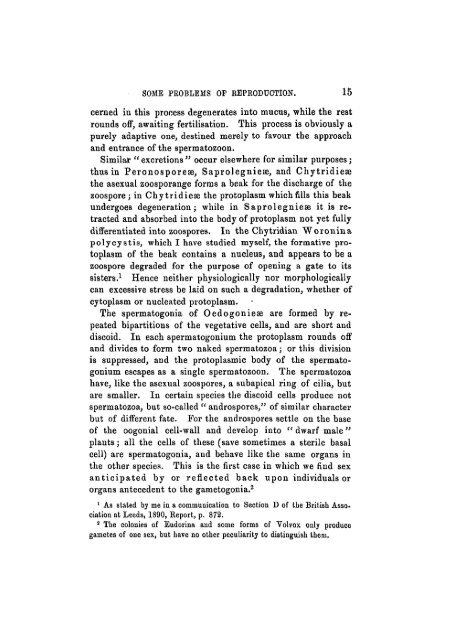Some Problems of Reproduction: a Comparative Study of ...
Some Problems of Reproduction: a Comparative Study of ...
Some Problems of Reproduction: a Comparative Study of ...
Create successful ePaper yourself
Turn your PDF publications into a flip-book with our unique Google optimized e-Paper software.
SOME PROBLEMS OF REPRODUCTION. 15<br />
cerned in this process degenerates into mucus, while the rest<br />
rounds <strong>of</strong>f, awaiting fertilisation. This process is obviously a<br />
purely adaptive one, destined merely to favour the approach<br />
and entrance <strong>of</strong> the spermatozoon.<br />
Similar " excretions " occur elsewhere for similar purposes;<br />
thus in Peronosporese, Saprolegniese, and Chytridiese<br />
the asexual zoosporange forms a beak for the discharge <strong>of</strong> the<br />
zoospore; in Chytridiese the protoplasm which fills this beak<br />
undergoes degeneration; while in. Saprolegniese it is retracted<br />
and absorbed into the body <strong>of</strong> protoplasm not yet fully<br />
differentiated into zoospores. In the Chytridian Woronina<br />
polycystis, which I have studied myself, the formative protoplasm<br />
<strong>of</strong> the beak contains a nucleus, and appears to be a<br />
zoospore degraded for the purpose <strong>of</strong> opening a gate to its<br />
sisters. 1 Hence neither physiologically nor morphologically<br />
can excessive stress be laid on such a degradation, whether <strong>of</strong><br />
cytoplasm or nucleated protoplasm.<br />
The spermatogonia <strong>of</strong> Oedogonieae are formed by repeated<br />
bipartitions <strong>of</strong> the vegetative cells, and are short and<br />
discoid. In each spermatogonium the protoplasm rounds <strong>of</strong>f<br />
and divides to form two naked spermatozoa; or this division<br />
is suppressed, and the protoplasmic body <strong>of</strong> the spermatogonium<br />
escapes as a single spermatozoon. The spermatozoa<br />
have, like the asexual zoospores, a subapical ring <strong>of</strong> cilia, but<br />
are smaller. In certain species the discoid cells produce not<br />
spermatozoa, but so-called " androspores," <strong>of</strong> similar character<br />
but <strong>of</strong> different fate. For the androspores settle on the base<br />
<strong>of</strong> the oogonial cell-wall and develop into " dwarf male"<br />
plants; all the cells <strong>of</strong> these (save sometimes a sterile basal<br />
cell) are spermatogonia, and behave like the same organs in<br />
the other species. This is the first case in which we find sex<br />
anticipated by or reflected back upon individuals or<br />
organs antecedent to the gametogonia. 2<br />
1<br />
As stated by me in a communication to Section D <strong>of</strong> the British Association<br />
at Leeds, 1890, Report, p. 872.<br />
2<br />
The colonies <strong>of</strong> Eudorina and some forms <strong>of</strong> Volvox only produce<br />
gametes <strong>of</strong> one sex, but have no other peculiarity to distinguish them.

















